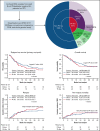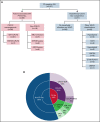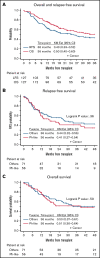Outcomes of allogeneic hematopoietic cell transplantation in adults with fusions associated with Ph-like ALL
- PMID: 35816633
- PMCID: PMC9631622
- DOI: 10.1182/bloodadvances.2022007597
Outcomes of allogeneic hematopoietic cell transplantation in adults with fusions associated with Ph-like ALL
Abstract
Allogenic hematopoietic cell transplantation (alloHCT) is a well-established curative modality for acute lymphoblastic leukemia (ALL), yet large amounts of data describing alloHCT outcomes in Philadelphia (Ph)-like ALL are lacking. We retrospectively analyzed archived DNA samples from consecutive adults with B-cell Ph-negative ALL who underwent alloHCT in complete remission (CR) (n = 127) at our center between 2006 and 2020. Identification of fusions associated with Ph-like ALL was performed using cumulative results from RNA-seq, conventional cytogenetics, fluorescence in situ hybridization, and whole genome array studies. Fusions associated with Ph-like ALL were detected in 56 (44%) patients, of whom 38 were carrying CRLF2r. Compared with other non-Ph-like ALL (n = 71), patients with fusions associated with Ph-like ALL were more frequently Hispanic (P = .008), were less likely to carry high-risk cytogenetics (P < .001), and were more likely to receive blinatumomab prior to HCT (P = .019). With the median followup of 3.5 years, patients with Ph-like ALL fusions had comparable posttransplant outcomes compared with other B-cell ALL: 3-year relapse-free survival (RFS) (41% vs 44%; P = .36), overall survival (OS) (51% vs 50%; P = .59), and relapse (37% vs 31%; P = .47). In multivariable analysis, age (P = .023), disease status at the time of transplant (P < .001), and donor type (P = .015) influenced OS. RFS (primary endpoint) was significantly influenced by disease status (P < .001) and conditioning regimen intensity (P = .014). In conclusion, our data suggest that alloHCT consolidation results in similarly favorable survival outcomes in adult patients with Ph-like fusions and other high-risk B-cell ALL.
© 2022 by The American Society of Hematology. Licensed under Creative Commons Attribution-NonCommercial-NoDerivatives 4.0 International (CC BY-NC-ND 4.0), permitting only noncommercial, nonderivative use with attribution. All other rights reserved.
Figures





References
-
- Herold T, Baldus CD, Gökbuget N. Ph-like acute lymphoblastic leukemia in older adults. N Engl J Med. 2014;371(23):2235. - PubMed

